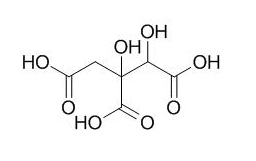Hydroxycitric acid
(-)-Hydroxycitric acid (HCA) can inhibit fat synthesis and reduces food intake, the primary mechanism of action of HCA appears to be related to its ability to act as a competitive inhibitor of the enzyme ATP-citrate lyase, which catalyzes the conversion of citrate and coenzyme A to oxaloacetate and acetyl coenzyme A (acetyl-CoA), primary building blocks of fatty acid and cholesterol synthesis. Hydroxycitric acid ameliorates high-fructose-induced redox imbalance and activation of stress sensitive kinases in male Wistar rats through its hypolipidemic effects.
Inquire / Order:
manager@chemfaces.com
Technical Inquiries:
service@chemfaces.com
Tel:
+86-27-84237783
Fax:
+86-27-84254680
Address:
1 Building, No. 83, CheCheng Rd., Wuhan Economic and Technological Development Zone, Wuhan, Hubei 430056, PRC
Providing storage is as stated on the product vial and the vial is kept tightly sealed, the product can be stored for up to
24 months(2-8C).
Wherever possible, you should prepare and use solutions on the same day. However, if you need to make up stock solutions in advance, we recommend that you store the solution as aliquots in tightly sealed vials at -20C. Generally, these will be useable for up to two weeks. Before use, and prior to opening the vial we recommend that you allow your product to equilibrate to room temperature for at least 1 hour.
Need more advice on solubility, usage and handling? Please email to: service@chemfaces.com
The packaging of the product may have turned upside down during transportation, resulting in the natural compounds adhering to the neck or cap of the vial. take the vial out of its packaging and gently shake to let the compounds fall to the bottom of the vial. for liquid products, centrifuge at 200-500 RPM to gather the liquid at the bottom of the vial. try to avoid loss or contamination during handling.
Fitoterapia.2024, 175:105955.
Biol. Life Sci. Forum2024, 35(1), 6.
Horticulturae2024, 10(5), 486.
Kaohsiung J Med Sci.2024, 40(3):280-290.
Front Aging Neurosci.2019, 11:230
Appl Biochem Biotechnol.2020, 190(2):732-744
Aquaculture2019, 510:392-399
Adv. Anim. Vet. Sci.2024, 12(4):732-741
Mutlu Yanic S, Ates EG. JOTCSA.2023, 10(4);893-902.
Plants (Basel).2023, 12(1):163.
Related and Featured Products
Food Chem Toxicol. 2004 Sep;42(9):1513-29.
Safety assessment of (-)-hydroxycitric acid and Super CitriMax, a novel calcium/potassium salt.[Pubmed:
15234082 ]
METHODS AND RESULTS:
(-)-Hydroxycitric acid (HCA) is a principle constituent (10-30%) of the dried fruit rind of Garcinia cambogia, a plant native to Southeastern Asia. The dried rind has been used for centuries throughout Southeast Asia as a food preservative, flavoring agent and carminative. Extensive experimental studies show that HCA inhibits fat synthesis and reduces food intake.
CONCLUSIONS:
The objective of this review is to systematically review the available safety/toxicity literature on HCA to determine its safety in-use. The primary mechanism of action of HCA appears to be related to its ability to act as a competitive inhibitor of the enzyme ATP-citrate lyase, which catalyzes the conversion of citrate and coenzyme A to oxaloacetate and acetyl coenzyme A (acetyl-CoA), primary building blocks of fatty acid and cholesterol synthesis.
J Basic Clin Physiol Pharmacol. 2016 Jun 1;27(4):349-56.
Hydroxycitric acid ameliorates high-fructose-induced redox imbalance and activation of stress sensitive kinases in male Wistar rats.[Pubmed:
26974136 ]
Excess fructose consumption causes dyslipidemia, oxidative stress, and various complications. Hydroxycitric acid (HCA), one of the principal components of the fruit Garcinia cambogia, has been shown to possess antiobesity properties. The objective was to investigate the effects of HCA on redox imbalance and activation of stress sensitive kinases in high fructose-fed rats.
METHODS AND RESULTS:
Male Wistar rats (n=40) were randomly divided into four groups with 10 rats in each group. The rats were fed with either standard rodent diet or 60% fructose diet and administered with HCA at a dose of 400 mg/kg body wt/day for 10 weeks. Body weight was measured once a week, and food intake was noted daily. At the end of the study, lipid profile and oxidative stress parameters were estimated. Expressions of stress sensitive kinases were analyzed in liver homogenates. Fructose-fed rats displayed elevated body weight, higher levels of plasma total cholesterol (TC), triacylglycerol (TAG), non-high-density lipoprotein cholesterol (non HDL-C), malondialdehyde (MDA), total oxidant status (TOS), oxidative stress index (OSI), lower levels of HDL-C, glutathione (GSH), glutathione peroxidase (GPx), and total antioxidant status (TAS). Fructose feeding caused higher phosphorylation of stress sensitive kinases ERK ½ and p38. Administration with HCA lowered body weight, food intake, TAG, non-HDL-C, MDA, TOS, and OSI and elevated GSH, GPx, and TAS levels. Reduced phosphorylation of ERK ½ and p38 mitogen-activated protein kinase (MAPK) was observed upon HCA treatment.
CONCLUSIONS:
Thus, HCA improved fructose induced redox imbalance and activation of stress sensitive kinases through its hypolipidemic effects.



